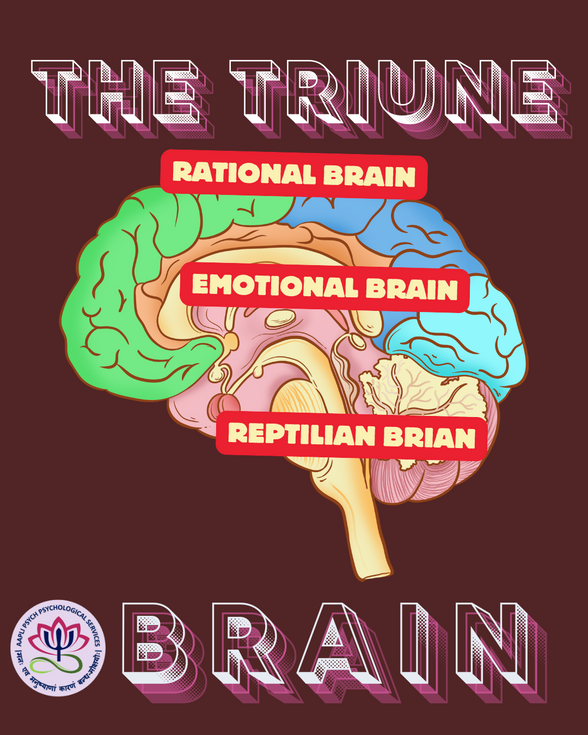

Human brain is one of the most powerful and complex organs in the body. It takes charge over a lot of functions including breathing, balance, thinking, deciding and emotions.
However, have you ever thought of how some actions come very naturally to us, as if they are automatic whereas, there are some that require a lot of efforts.
The Triune Brain Theory provides a framework to explain this. This theory was proposed by Dr. Paul MacLean in the year 1960. According to this theory, the human brain came to develop in three stages. This forms three interconnected but also functionally distinct layers of the brain. If one understands these layers, it can help to explain emotional reactions, automatic behaviors and also rational thinking.
This blog aims to explore the structure of the triune brain, what it means to have these three interconnected distinct layers and how it applies to our real life.
What is the Triune Brain
The Triune Brain Theory explains that the human brain is split into three layers which have am evolutionary basis to them. Each of these layers is responsible for different types of behaviors and thought processes.
The Origin of the Theory

The theory was put forth by Dr. Paul MacLean in the year 1960. It says that human behavior is determined by the brain. However, this brain develops in three distinct systems that reflect an evolutionary history. The three layers are:
Reptilian Brain
This part takes care of the instinct based behaviors.
Limbic Brain
Looks after responses that are emotional in nature.
Neocortex
Regulates the higher order thinking and decision making of a person.
Structure of the Triune Brain
Let us understand the brain according to the structure and functions as explained by the Triune Brain Theory.
Reptilian Brain (Primitive Brain)
Location: Brainstem and Cerebellum
Development timeline: Over 500 million years ago
Function: Controls basic survival functions
When does this brain get active? When you feel threatened and your heart starts racing the reptilian brain is in action.
Limbic Brain (Emotional Brain)
Location: Surrounding the brainstem
Development timeline: Over 150 million years ago
Function: Emotional regulation and memory function
When does this brain get active? Feeling comforted when hugged by someone you love.
Neocortex (Rational Brain)
Location: Outermost layer of the brain
Development timeline: Over 2-3 million years ago
Function: Controls higher- order thinking and reasoning
When does this brain get active? Making career choices, solving math, or thinking about right or wrong.
The Triune Brain and Psychological Disorders
Trauma and Emotional Regulation
Traumatic experiences make the emotional brain overactive. This leads to heightened emotional responses. In this case, the person remains edgy, startle response is seen frequently and they are usually very vigilant of their surroundings. The amygdala is excessively alert due to which even safe or harmless experiences are seen to be harmful.

Addiction and Impulse Control
The reptilian brain controls impulsive behaviors and cravings. The neocortex tries to regulate and control the impulses through self control and reasoning. Additionally, the limbic system overpowers the neocortex leading to compulsive behavior. This is because the limbic system is in charge of the dopamine reward pathways. Drug addiction comes from an overactive reward pathway that is created in the limbic brain. This is why, it becomes hard for the neocortex to take charge. The older the brain structure is, more are the chances that it can overpower the other system.
Conclusion
The Triune Brain Theory provides valuable insights into how the brain influences behavior and emotional responses. There are a few researches that challenge some aspects of the theory, however, the theory remains a very important tool in understanding how brain-behavior connection.
Understanding the three different brain systems can help a psychologist develop better interventions for emotional dysregulation, trauma and addiction.
Subscribe to APPS Blogs for more psychology related educative content.
References:
MacLean, P. D. (1990). The Triune Brain in Evolution: Role in Paleocerebral Functions. Springer Science & Business Media.
Van der Kolk, B. (2014). The Body Keeps the Score: Brain, Mind, and Body in the Healing of Trauma. Penguin.
Nestler, E. J., et al. (2002). Neurobiology of addiction. Neuron, 34(1), 13-25.














